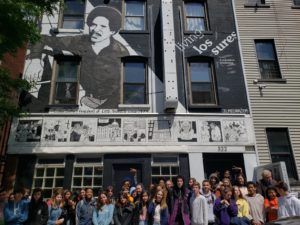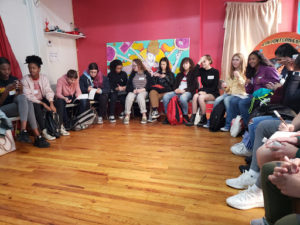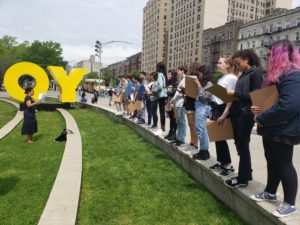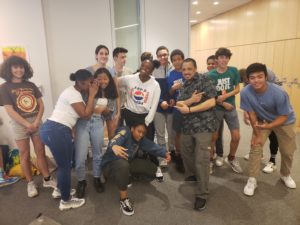9th Grade Immersive Exploration of Gentrification: In Their Words

Kai and Natalie: Through the Service and Justice class led by Natania and Noel this semester, 9th graders experienced an Immersive Exploration of Gentrification. Students spent three days exploring gentrification and its effects on different neighborhoods in Brooklyn, NY. The three day interactive and educational experience had the grade begin by exploring Los Sures, Williamsburg with the director of UnionDocs, an organization dedicated to educating people about gentrification and the process and perils of this common occurrence. The UnionDocs speaker showed us a documentary film going into the history of Los Sures and how it underwent gentrification, pushing out much of the low income community that used to inhabit the area. Afterwards, we discussed the positiƒe and negative implications that gentrification can have, including lower crime rates, but also raising rents and driving people out of their homes using extreme measures. One group of students then went on a walking tour of Flatbush with Imani Henry from Equality For Flatbush and learned about how residents of the neighborhood were grappling with gentrification and fighting back against it. Another group of students went to Bushwick and worked with an organization called El Puente, going on a walking tour of Bushwick. The entire grade also went to the Brooklyn Museum and worked with museum guides to explore the connections between gentrification and several very interesting art exhibitions. We visited a Garry Winogrand photography exhibit that dated back to the 1950’s, learned about LJ Roberts’s artwork The Queer Houses of Brooklyn in the Three Towns of Boswyck, Breukelen, and Midwout during the 41st Year of the Stonewall Era, and examined the Brooklyn Hi-Art! Machine installation on the exterior of the building through analytical conversation. We then closed out the three days with workshops led by local artist-activists Farbeon, Craig Bannister of Spectrum Arts, Elisabet Velasquez, and The Womanity Project and expressed our learning through poetry, hip-hop, theater, and film.
DAY 1: Williamsburg
Alex: Right when our class got off the train, I noticed a large modern building that was clearly just built in a neighborhood where there were mostly older buildings or houses. I found this very interesting so after talking with Natania, she and I decided to research the prices for an apartment in this building. For a 2 bedroom apartment in this building it would cost $5,000 a month, which is a huge increase in price per month compared to the prices of the older buildings in Williamsburg and the average rent in New York City. This building is clearly an indication of gentrifying Williamsburg because it is a very nice luxury building with prices that are much higher than the surrounding buildings.
Nina: Visiting different Brooklyn neighborhoods, I felt like a tourist in my own city. Even though I may have lived near these places for my whole life, there is so much unfamiliarity and aspects of the neighborhood that I never would have guessed were there. This was the case when we went to visit Los Sures in Williamsburg. As we walked around with our guide, the director of UnionDocs, we got to see the new businesses and buildings that arose due to gentrification, but also some of the history of the people in the neighborhood right next to those new, modernized buildings. For example we walked by a mural of two brothers sitting on a car, who were featured in the Los Sures video, and a few doors down sat a brand-new apartment building with expensive listings. So it was interesting to see how the community tries to maintain their history and culture despite the fact that that was being threatened by gentrification. But through the concerning topics of gentrification and mean landlords, it was a really incredible experience watching the stories in the documentary, and seeing them in real life on the streets. Brooklyn has transformed immensely.
DAY 2: Flatbush and Bushwick
Eve and Willa: The 9th grade was split into two groups, one got to explore the neighborhood of Flatbush with Imani Henry who leads the organization Equality For Flatbush. As we walked around the busy streets of Flatbush on a tour with Imani we got to see first-hand the gentrification that was taking over the neighborhood. Small businesses and old residences were being bought by developers and big corporations. We noticed that there were large modern apartment buildings that were being built in between old brick houses that stuck out like a sore thumb. One of the stops that we went to on our tour was a small jewelry business which was being pushed out by their landlord, who continuously threatened to raise the rent. Flatbush has been known for its shopping and salons but since gentrification has began to spread throughout it, less and less of these businesses are open. Imani and our group also talked about the harsh conditions that landlords have enforced on their tenants including cutting off the utilities, threatening to call ICE, and intentionally causing damage to their buildings in order to remove tenants. This tour opened our eyes up to the harsh realities of gentrification and allowed us to see in person the disadvantages of gentrification and how it affects the culture and the neighborhood as a whole.
Charlie B: In my opinion, these past three days have been very interesting and informative. I think that this is something that should be done next year with the up and coming freshman class. One experience I had was when we got into small groups in Bushwick and discussed how our neighborhoods were being gentrified. It was very interesting to hear other people’s stories, and hear the experiences they’ve gone through. One way I can educate others about gentrification is just by spreading the word and informing other people about what I learned during those three days. Overall, this experience was incredible and I will remember it for the rest of my life.
Xavier: I think that the Bushwick trip is very important and immersive for the kids next year learning about gentrification because it definitely helped me expand my understanding about what gentrification is and how fast it’s spreading. I also believe that it’s necessary for the kids to see how fast it’s happening. One major aspect that I thought was very surprising was the rent in Bushwick over the last 10 years. One of the people in El Puente told us that the rent in rent-controlled housing has risen 70% over the last 10 years. That rate increase is absurd and that is one of the clearest examples of gentrification I’ve ever seen.
Ceci: I hadn’t been to Bushwick many times before this trip so I really enjoyed being a part of the neighborhood for a day and getting to know the community. It was especially inspiring for me to visit the main mural of the neighborhood and know the story behind it. It was really nice to hear how much the community has chipped in, especially after the fire and riots in the 1970’s. When the government wasn’t helping at all, the community came together and has since been rebuilding their neighborhood. I also think that this trip is necessary because although the community is so involved in helping their neighborhood, there is also so much gentrification taking over the neighborhood that it is difficult for only the community to help, so it is helpful for students to be exposed to the challenges and hopefully be inspired to support in the future.
Maddie: I think that the Bushwick trip was a really fun and interesting experience! It changed my perspective on gentrification in many ways. The people we met at El Puente were very inspiring and it was really nice getting to see different perspectives of life in Bushwick now and a while ago. I definitely recommend this trip for next year’s ninth graders!
“My Brooklyn” Documentary Film
Dylan: After watching “My Brooklyn”, I gained a whole new perspective on the neighborhood that I call home. I spent half of my life here and I was oblivious to the gentrification that is occurring in the neighborhood. Shops were closing to make way for residential buildings, and people were forced out due to the unbelievably high increase in rent. The government gave no money to the people to move and they were left to start from scratch again. The government did not listen to the opinions of the people and continued building the luxury residential buildings. I learned that the building that I live in evaded $40 million worth of tax money and the government did not care much about it.
Meghan: I have lived in Brooklyn all my life and have been going to school in the Downtown Brooklyn area for a solid 9 years. Everytime I leave school and head to my favorite hang out I look at all of the For Rent signs and popular chain stores on the Fulton Mall. To see this movie of all of the culturally important shops and stores that mattered to people really touched me.
DAY 3: ARTS ACTIVISM
Brooklyn Museum
Wyatt and Frankie: Going to the Brooklyn Museum was crucial in learning how gentrification has been portrayed in many forms of art. This includes, paintings, textiles, and sculpture and how many of these artists with very different backgrounds perceive gentrification. One example of this is the quilt that represented the homes of LGBTQ activists fighting for rights created by L.J. Roberts. The quilt was a map of Brooklyn which showed the bright and unique sides of the different communities in Brooklyn. Another exhibit that we viewed at the Brooklyn museum was the big “YO / OY” on the grass outside of the museum. It portrays how one word can mean many different things in different languages and cultures. Another exhibit that can been seen above the entrance to the Brooklyn Museum are the words “We will not disappear into silence.” This shows the significance of speaking up against injustice and fighting for a better community.
Luc and Charley: The Brooklyn Museum was a new experience that I never experienced before. It was interesting to see photographs of New York during a period of gentrification. Seeing these photos showed me a different side of New York that I didn’t really know existed. Seeing the photos gave me a deeper understanding of how our city’s culture and society was throughout the 1900’s. The Brooklyn Museum was interesting to me because I have never really gone to museums to see that type of artwork we visited. If you looked at it and analyzed it deeper you could make connections between the exhibits and what we have been learning about gentrification.
Theater Workshop with Craig Bannister and Spectrum Arts
Jade: When we returned from Brooklyn Museum to Brooklyn Friends School, four workshops were available for the 9th grade to explore and learn more about gentrification and channel what we learned through art and expression. One of these workshops was a theater and scene building session, where we got to work with an acting group specifically made of elders. Most of the elders had lived in Brooklyn for a long time, and were able to share their first-hand experiences of watching gentrification develop in their neighborhoods. For our first activity, we went in a circle and built a story based off a word or idea that somebody shared. For example, our first word was love, so everybody went around the circle and added something about love, whether it was something they love or what love meant to them. Next, we were split into three groups to develop our scenes on gentrification. First we had discussions with the elders on gentrification around NYC, and how it personally affects the residents and the community. We then returned as a whole group to share our ideas which were consolidated into about five main topics. Craig, the leader of the session, chose one of the topics for each group to develop our scene. The three topics he chose were what Starbucks means, the closing of small businesses, and rent stabilization. We then worked to create short scenes using our topic on gentrification. After practicing our scenes we performed them for the rest of the grade. This workshop was very informative and exciting because we had the opportunity to talk to people with in-depth experiences who have witnessed the gentrification we learned about in the previous days.
Hip Hop Workshop with Farbeon
Ethan and Lila: During the Hip-Hop gentrification workshop we learned the complete definition of Hip-Hop, as a musical genre, dance form, and culture, and how it has impacted generations of creative youth. The leader of the workshop, Farbeon, started off by making a beat and then rapping about his experiences discovering hip-hop and how it has affected his life. After this, he shifted the attention onto the students and asked us to write two bars to introduce ourselves, and we formed a cypher and shared these raps. We then had time to write in either rap or poetry form about several prompts relating to gentrification. First we did this individually, then we progressed to small groups and combined our lyrics into a longer rap. After sharing these songs with our peers in the rap workshop, we went to perform in front of the whole grade. This experience allowed us to step out of our comfort zones and learn more about a how we can fight against gentrification using our artistic abilities. Overall, this workshop helped us explore gentrification through a unique lens, as well as share our views about the issue with our peers in a safe and fun environment.
Amaya: In my opinion working in the hip-hop group with Farbeon was a great experience just due to the fact that it was a fun way for me to reflect on my knowledge on gentrification. In this workshop we learned about hip-hop culture and the impact it had on people during a difficult time. In addition it gave me a better understanding of what hip-hop culture is. When people most think of hip-hop they think of music but when we think of culture we think of everything associated with it this including dance, ways of dress, and music, in addition the community it creates. After he shared his knowledge he talked about his relationship to hip-hop culture and shared some of his bars with us. Then we had to come up with as many bars as we could in 40 minutes and then combine what we created with other groups. After sharing with each other we shared with the whole grade which was really fun. This was also very informative and interactive because it shows how things change over time and how the idea of a culture can change this relating to gentrification and the displacement of certain ideas.
Poetry Workshop with Elisabet Velasquez
Lily B: The Poetry Workshop run by Elisabet Velasquez was an emotional, informative, and powerful experience for all five students that were participants. Using games, and thought-provoking questions, students were able to get a better understanding of the economic roots of gentrification in Brooklyn. Students, in one portion of this workshop, filled the shoes of representatives of zones of Brooklyn and asked the bank for money for their respective zones. Unknowing of whether or not they’d be granted with the money, each student formulated a plan for how they would ask for the money they need. Students also participated in word association exercises. When shown words like ‘home’ or ‘community’, students wrote down the first words that came to mind. In a final exercise, students engaged in a fun, energetic game of using metaphoric dice to make powerful literary tools. To top off the workshop, students wrote letters to their homes in poems.
Val and Delila: The poetry workshop led by Elisabet Velasquez was a fun comfortable way to share and write poetry. The activities that occurred in the workshop were not only informative but also very fun. Elisabet made writing into a safe space where we felt we could truly write what we felt without being judged. The space was relaxing and full of creativity. Elisabet urged us to use our creativity to the fullest extent.
Film Workshop with The Womanity Project
Danielle and Ava P: During the film workshop we worked with Aurelie and Billy from the Womanity Project to compile videos, photos, and audio recordings taken throughout the gentrification immersion experience and from the Albany rally for Universal Rent Control in New York to create a movie. We learned how to work with the footage that we had, which was not specific to a certain storyline, and create a film. We discussed different ideas for themes and topics of mini-films and discussed videos and pictures that we had. We broke up into three groups to make three different short films about different topics and parts of our trips. The final film, which is a compilation of all three smaller pieces, shows speakers from the rally, some who talked about their personal experience, and others who were representatives and shared that they planned to pass a series of bills that would essentially eliminate loopholes that landlords use to avoid the current laws of rent control. Watch the film below.






